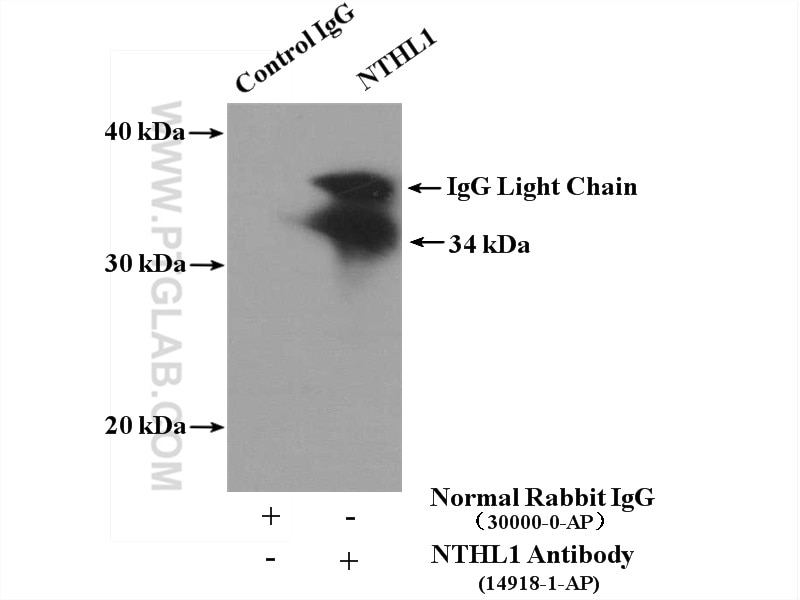NTHL1 Polyklonaler Antikörper
NTHL1 Polyklonal Antikörper für IP, WB, ELISA
Wirt / Isotyp
Kaninchen / IgG
Getestete Reaktivität
human, Maus, Ratte
Anwendung
WB, IP, ELISA
Konjugation
Unkonjugiert
Kat-Nr. : 14918-1-AP
Synonyme
Galerie der Validierungsdaten
Geprüfte Anwendungen
| Erfolgreiche Detektion in WB | HEK-293-Zellen, HeLa-Zellen, K-562-Zellen, Y79-Zellen |
| Erfolgreiche IP | Y79-Zellen |
Empfohlene Verdünnung
| Anwendung | Verdünnung |
|---|---|
| Western Blot (WB) | WB : 1:500-1:2000 |
| Immunpräzipitation (IP) | IP : 0.5-4.0 ug for 1.0-3.0 mg of total protein lysate |
| It is recommended that this reagent should be titrated in each testing system to obtain optimal results. | |
| Sample-dependent, check data in validation data gallery | |
Veröffentlichte Anwendungen
| WB | See 1 publications below |
Produktinformation
14918-1-AP bindet in WB, IP, ELISA NTHL1 und zeigt Reaktivität mit human, Maus, Ratten
| Getestete Reaktivität | human, Maus, Ratte |
| In Publikationen genannte Reaktivität | human |
| Wirt / Isotyp | Kaninchen / IgG |
| Klonalität | Polyklonal |
| Typ | Antikörper |
| Immunogen | NTHL1 fusion protein Ag6734 |
| Vollständiger Name | nth endonuclease III-like 1 (E. coli) |
| Berechnetes Molekulargewicht | 34 kDa |
| Beobachtetes Molekulargewicht | 34 kDa |
| GenBank-Zugangsnummer | BC000391 |
| Gene symbol | NTHL1 |
| Gene ID (NCBI) | 4913 |
| Konjugation | Unkonjugiert |
| Form | Liquid |
| Reinigungsmethode | Antigen-Affinitätsreinigung |
| Lagerungspuffer | PBS mit 0.02% Natriumazid und 50% Glycerin pH 7.3. |
| Lagerungsbedingungen | Bei -20°C lagern. Nach dem Versand ein Jahr lang stabil Aliquotieren ist bei -20oC Lagerung nicht notwendig. 20ul Größen enthalten 0,1% BSA. |
Hintergrundinformationen
NTHL1, also named as Endonuclease III-like protein 1 or OCTS3, is a 312 amino acid protein, which belongs to the Nth/MutY family. NTHL1 localizes in the nucleus and is widely expressed with highest levels in heart and lowest levels in lung and liver. NTHL1 Has both an apurinic and/or apyrimidinic endonuclease activity and a DNA N-glycosylase activity and incises damaged DNA at cytosines, thymines and guanines. NTHL1 acts on a damaged strand, 5' from the damaged site and is required for the repair of both oxidative DNA damage and spontaneous mutagenic lesions.
Protokolle
| Produktspezifische Protokolle | |
|---|---|
| WB protocol for NTHL1 antibody 14918-1-AP | Protokoll herunterladen |
| IP protocol for NTHL1 antibody 14918-1-AP | Protokoll herunterladen |
| Standard-Protokolle | |
|---|---|
| Klicken Sie hier, um unsere Standardprotokolle anzuzeigen |
Publikationen
| Species | Application | Title |
|---|---|---|




